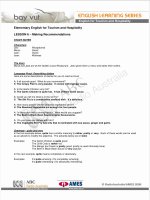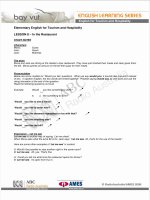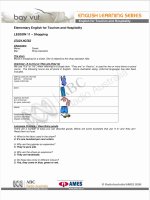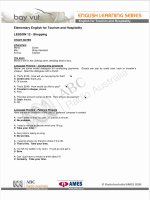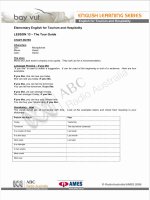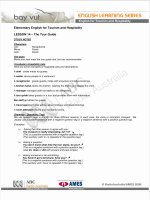Augusto boal games for actors and non actors (2002)
Bạn đang xem bản rút gọn của tài liệu. Xem và tải ngay bản đầy đủ của tài liệu tại đây (1.94 MB, 332 trang )
GAMES FOR ACTORS AND NON-ACTORS
Boal’s analysis of the art of the actor makes Games for Actors and Non-Actors
compulsory reading. Plays and Players
This is an inspiring and powerful book, a lucid account that will be of substantial
use to people already using Theatre of the Oppressed. It should also act as an
excellent introduction for those new to the system. Artscene
This is a useful handbook for those who want to explore Boal’s Theatre of the
Oppressed and as such is greatly to be welcomed. Boal’s work deserves and
demands emulation. Theatre Research International
Games for Actors and Non-Actors is the classic and best-selling book by the founder
of Theatre of the Oppressed, Augusto Boal. It sets out the principles and practice
of Boal’s revolutionary method, showing how theatre can be used to transform
and liberate everyone – actors and non-actors alike!
This thoroughly updated and substantially revised edition includes:
•
•
•
•
•
•
Two new essays by Boal on major recent projects in Brazil
Boal’s description of his work with the Royal Shakespeare Company
A revised introduction and translator’s preface
A collection of photographs taken during Boal’s workshops, commissioned
for this edition
New reflections on Forum Theatre
A postscript considering the effect of 11 September 2001.
Augusto Boal is a theatre director, dramatist, theorist, writer and teacher. He was
a Member of Parliament for Rio de Janeiro from 1993 to 1996. He is the author of
The Theatre of the Oppressed, Games for Actors and Non-Actors, The Rainbow of Desire,
Legislative Theatre and Hamlet and the Baker’s Son: my life in theatre and politics.
Adrian Jackson is Artistic Director of Cardboard Citizens. He has translated four
books by Augusto Boal, collaborated on a number of occasions and taught Theatre
of the Oppressed widely in other countries, including Namibia, South Africa, Hong
Kong, Mauritius and Finland.
For information about the activities of Augusto Boal and the centres of Theatre
of the Oppressed in Rio de Janeiro (workshops, courses and conventions), please
send a self-addressed envelope and two International Reply Coupons to:
CTO – Rio
Avenida Rio Branco 179–60andar
Centro
Rio de Janeiro, RJ
Brazil
Tel./Fax 00 55 21 2220 7940
Email:
www.ctorio.com.br
GAMES FOR ACTORS AND
NON-ACTORS
Second edition
Augusto Boal
Translated by Adrian Jackson
London and New York
First published 1992 by Routledge. Reprinted eight times.
Second edition published 2002 by Routledge
11 New Fetter Lane, London EC4P 4EE
Simultaneously published in the USA and Canada
by Routledge
29 West 35th Street, New York, NY 10001
Routledge is an imprint of the Taylor & Francis Group
This edition published in the Taylor and Francis e-Library, 2005.
“To purchase your own copy of this or any of Taylor & Francis or Routledge’s
collection of thousands of eBooks please go to www.eBookstore.tandf.co.uk.”
© 2002 Augusto Boal
© 2002 Introduction: Adrian Jackson
© 2002 Translation: Routledge
All rights reserved. No part of this book may be reprinted or reproduced
or utilised in any form or by any electronic, mechanical, or other means,
now known or hereafter invented, including photocopying and recording,
or in any information storage or retrieval system, without permission in
writing from the publishers.
British Library Cataloguing in Publication Data
A catalogue record for this book is available from the British Library
Library of Congress Cataloging in Publication Data
A catalog record for this book has been requested
ISBN 0-203-99481-7 Master e-book ISBN
ISBN 0–415–26761–7 (hbk)
ISBN 0–415–26708–0 (pbk)
This book is dedicated to
Adrian Jackson, for his creative translation;
Helena Reckitt and Talia Rodgers, for their enthusiasm and help;
Edla Van Steen and Sábato Magaldi, forever friends;
Blanca Laksman and Leonardo Thumin, for having invented Cecilia!
CONTENTS
List of figures
Translator’s introduction to the first edition
Translator’s postscript to the second edition
1
2
xxi
xxii
xxvii
Preface to the second edition: The Royal Shakespeare Company,
theatre in prisons and landless peasants
Postscript – with pride in our hearts
1
6
Preface to the first edition: the fable of Xua-Xua, the prehuman
woman who discovered theatre
Postscript: actors and non-actors
11
17
THEATRE OF THE OPPRESSED IN EUROPE
18
Introduction
18
The Godrano experience: my first Forum Theatre in
Europe or the ultimate spect-actor/protagonist!
Feminism in Godrano
The police again
The oppressed and the oppressors
19
20
21
23
THE STRUCTURE OF THE ACTOR’S WORK
29
The primacy of emotion
Muscular exercises
Sensory exercises
Memory exercises
29
31
31
32
vii
CONTENTS
3
I
viii
Imagination exercises
Emotion exercises
Rationalising emotion
À la recherche du temps perdu
The dialectical structure of the actor’s interpretation of a role
The will
The counter-will
The dominant will
Quantitative variation and qualitative variation
32
32
35
37
40
40
43
45
46
THE ARSENAL OF THEATRE OF THE OPPRESSED
48
Introduction: a new system of exercises and games from
Theatre of the Oppressed
Two unities
Five categories of game and exercise
48
49
49
FEELING WHAT WE TOUCH (RESTRUCTURING MUSCULAR
RELATIONS)
50
First series: general exercises
1 The cross and the circle
2 Colombian hypnosis
3 Minimum surface contact
4 Pushing against each other
5 Joe Egg (aka trust circle)
6 The circle of knots
7 The actor as ‘subject’: the Greek exercise
8 The actor as ‘object’
9 Lifting someone out of a chair
10 Equilibrium of the body with an object
11 A balloon as an extension of the body
12 Racing on chairs
13 Rhythm with chairs
14 Musical chairs
15 Movement with over-premeditation
16 Difficulties
17 Divide up the movement
18 Dissociate coordinated movements
50
50
51
56
58
62
62
64
66
67
67
68
68
68
69
69
69
70
70
CONTENTS
Second series: walks
1 Slow motion
2 At a right angle
3 Crab
4 Crossed legs (aka three-legged race)
5 Monkey
6 All fours
7 Camel walk
8 Elephant walk
9 Kangaroo walk
10 Leaning-against-each-other walk
11 Strapped-feet walk
12 Wheelbarrow
13 As you like it
14 Imitating others
70
71
72
72
72
73
73
73
73
73
73
74
74
74
74
Third series: massages
1 In a circle
2 The movement comes back
3 Sea waves
4 The rolling carpet
5 Back massage
6 The demon
74
75
75
75
76
77
77
Fourth series: integration games
1 Person to person, Quebec-style
2 The bear of Poitiers
3 The chair
4 Leapfrog
5 The Brueghel game
6 Stick in the mud
7 Grandmother’s footsteps
8 Millipede
9 Apple dance
10 Sticky paper
11 The wooden sword of Paris
12 American football (aka British bulldog)
13 Three Irish duels
14 Little packets
15 Cat and mouse
77
77
78
78
79
79
80
80
80
81
81
81
82
82
83
83
ix
CONTENTS
16
17
18
19
20
21
II
Homage to Tex Avery – cat and dog(s)
The handkerchief game (aka the hat game, aka dog and bone)
Good day
Cadavre exquis (aka consequences)
The parachute
Balance with an object
Fifth series: gravity
1 Horizontality sequence
2 Verticality sequence
3 Sequence of rectilinear and circular movements
86
87
88
89
LISTENING TO WHAT WE HEAR
92
First series: rhythm
1 A round of rhythm and movement
2 Game of rhythm and movement
3 Changing rhythms
4 The machine of rhythms
5 The Peruvian ball game
6 The clapping series
7 West Side Story
8 The Portuguese rhythmic shoes
9 The two brooms
10 The four brooms
11 Horseshoe rhythms
12 Circular rhythms
13 The big chief
14 The orchestra and the conductor
15 Rhythm dialogue in teams
16 Chain rhythm dialogue
17 Pretend Brazilian ‘Indians’
18 Lines of five
19 The president’s bodyguards
20 Walk, stop, justify
21 Carnival in Rio
22 Bolivian mimosas
23 How many ‘A’s in a single ‘A’?
24 Two by three by Bradford
x
84
84
85
85
86
86
92
92
93
93
94
96
97
98
99
100
101
101
101
101
101
102
102
102
104
104
104
104
105
106
106
CONTENTS
III
25 Crossing the room
26 Circle of names of Belo Horizonte
27 Circle of rhythms of Toronto
107
107
107
Second series: melody
1 Orchestra
2 Music and dance
108
108
108
Third series: sounds and noises
1 Sound and movement
2 Ritual sound
108
108
109
Fourth series: the rhythm of respiration
1 Lying on your back completely relaxed
2 Leaning against a wall
3 Standing up straight
4 Breathe in slowly
5 Explosion
6 Breathe in slowly while lifting the arms
7 The pressure cooker
8 Breathe in as quickly as possible
9 Breathe in as slowly as possible
10 Breathe in deeply through the mouth
11 Breathe in with clear definition and lots of energy
12 Two groups
13 Breathe out, standing in a circle
14 One actor pretends to pull the stopper out of another’s body
15 A, E, I, O, U
16 All the actors, standing facing the wall
17 Two groups of actors, facing each other
18 With their bodies in maximum possible contact with the floor
19 Lying on their backs on tables
109
110
110
110
110
110
111
111
111
111
111
111
112
112
112
113
113
113
113
114
Fifth series: internal rhythms
1 Rhythmic images
114
114
DYNAMISING SEVERAL SENSES
114
The blind series
1 The point of focus, the embrace and the handshake
2 Noises
115
115
116
xi
CONTENTS
3
4
5
6
7
8
9
10
11
12
13
14
15
16
17
18
19
20
21
22
23
24
IV
xii
The imaginary journey
The glass cobra
One blind line, one sighted line
The magnet – positive and negative
Swedish multiple sculpture
The vampire of Strasbourg
The blind car
What is the object?
The smell of hands
The figure-of-eight chicane
Goalkeeper
Friend and enemy
Draw your own body
Modelling clay
Touch the colour
The blind person and the bomb
Find the hand
The siren’s song
Find a convenient back
The melodic hand
The sound of the seven doorways
Recognising the ‘Aaah!’
117
118
118
119
120
120
121
121
122
122
122
122
123
124
124
125
125
125
126
126
127
127
The space series
1 Without leaving a single space in the room empty
2 Instead of simply saying ‘Stop’, the Joker says a number
3 The Joker says a number and a geometric figure
4 The Joker says a number and a part of the body
5 The Joker calls out a colour and an item of clothing
6 The participants run slowly
7 The participants touch each other
127
127
128
128
128
128
128
129
SEEING WHAT WE LOOK AT
129
The mirrors sequence
1 The plain mirror
2 Subject and image swap roles
3 Subject–image, image–subject
4 Everyone joins hands
129
130
130
130
131
CONTENTS
5
6
7
8
9
10
11
12
The two lines form a curve
Symmetrical groups
The mirror breaks
Changing partners
The distorting mirror
The narcissistic mirror
The rhythmic mirror
Unification
132
132
133
133
134
134
135
135
The modelling sequence
1 The sculptor touches the model
2 The sculptor doesn’t touch the model
3 The sculptors spread out around the room
4 The sculptors fashion a single sculpture together
5 Sculpture with four or five people
136
136
137
138
138
138
The puppet sequence
1 String puppet
2 String puppet with rod
138
139
139
Image games
1 Complete the image
2 Ball games
3 Boxing match
4 One person we fear, one person is our protector
5 Furnish the empty space
6 Atmosphere of snow
7 Building character relations
8 Characters in movement
9 Observation
10 Complementary activities
11 What has changed?
12 Tell your own story
13 The antiquated telephone exchange
14 Concentration
15 Animals
16 Professions
17 The balancing circle
18 The ‘Indian’ in the city, the city dweller in the forest
139
139
140
141
141
142
142
143
143
143
143
144
144
144
144
145
146
147
148
xiii
CONTENTS
xiv
Games of mask and ritual
1 Follow the master
2 Follow two masters – who metamorphose into each other
3 Rotation of masks
4 Unification of masks
5 Collective creation of a mask
6 Addition of masks
7 Pushing the mask to its extremity and nullifying it
8 Following the master in his own mask
9 Changing masks
10 Mask exchange
11 The masks of the actors themselves
12 Substitution of mask
13 Separation of mask, ritual and motivation
14 Changing a whole set of masks into a different social class
15 Making the mask all-encompassing
16 Changing actors mid-ritual
17 A round of masks in different circumstances
18 Natural and ridiculous
19 Several actors on stage
20 The game of complementary roles
21 The politicians game
22 Exchange of masks
23 Exchange of roles
24 Fainting at Fréjus
25 The designated leader
26 The clown of Amsterdam
27 The animals of Vienna
28 Looking first at one another and then at the same spot
29 Cookies
148
148
149
149
149
150
150
150
150
151
151
152
153
153
154
155
156
156
156
156
157
157
157
158
158
158
159
159
159
159
The image of the object
1 The found object
2 The object transformed
3 The object created out of simple things
4 Homage to Magritte – ‘This bottle is not a bottle’
160
160
161
161
161
The invention of space and the spatial structures of power
1 Space and territory
2 Inventing the space in a room
162
162
162
CONTENTS
3
4
5
6
7
The great game of power
Chairs in the empty space
Where is my place?
Six chairs
Photographing the image
Games involving the creation of characters
1 Murder at the Hotel Agato
2 Cops and robbers
3 The embassy ball
4 The child’s dream – what I wanted to be when I grew up
5 The child’s fear
6 What grown-ups wanted me to be
7 The opposite of myself
8 The two revelations of Saint Teresa
9 The fighting cocks
10 Catchphrases
11 What am I? What do I want?
12 The blank character
V
163
163
163
164
164
165
165
165
166
166
167
168
168
169
170
170
170
170
THE MEMORY OF THE SENSES
171
Reconnecting memory, emotion and imagination
1 Memory: remembering yesterday
2 Memory and emotion: remembering a day in the past
3 Memory and emotion and imagination
4 Remembering an actual oppression
5 Rehearsal on the stage of the imagination
6 Extrapolation
171
171
172
172
173
173
174
IMAGE THEATRE
174
Image techniques: models and dynamisations
1(a) Image of the word: illustrating a subject with your body
1(b) Image of the word: illustrating a subject using other people’s
bodies
2 Image of transition
3 Multiple image of oppression
4 Multiple image of happiness
176
176
181
185
186
189
xv
CONTENTS
5
6
7
8
9
10
11
Image of the group
Ritual gesture
Ritual
Rituals and masks
The image of the hour
The kinetic image
The merry-go-round of images
Images of transition – the technique in action
Examples from Europe
203
203
New Image Theatre techniques: the cop in the head
1 Dissociation – thought, speech, action
2 The analytical image: the multiple mirror of how others see us
3 Somatisation
4 The circuit of rituals
5 The three wishes
6 The polyvalent image
7 The screen image
8 The image of the image
206
207
208
211
211
212
213
213
214
Four very simple demonstrations of embryos of Forum
Theatre pieces, based on projected images
215
REHEARSAL EXERCISES FOR ANY KIND OF PLAY
xvi
191
193
198
201
201
202
202
217
Exercises with or without script
1 Improvisation
2 The dark room
3 One story told by several people
4 Change the story
5 One line spoken by several actors
217
217
219
219
219
220
Games of emotional dynamisation
1 Breaking the oppression
2 The oppressor’s confession
220
220
222
Emotional warm-up exercises
1 Abstract emotion
2 Abstract emotion with animals
3 Abstract emotion, following the master
4 Animals or vegetables in emotional situations!
222
222
223
223
223
CONTENTS
5 Ritual in which everyone becomes an animal
6 Stimulation of the dormant parts of ourselves
224
224
Ideological warm-up
1 Dedication
2 Reading newspapers
3 The evocation of historic events
4 Lessons
225
225
225
226
226
Exercises for the preparation of a Forum Theatre model or for
the rehearsal of other kinds of theatre
1 Play to the deaf
2 Stop! Think!
3 Interrogation
4 The reconstruction of the crime
5 Analytical rehearsal of motivation
6 Analytical rehearsal of emotion
7 Analytical rehearsal of style
8 Opposite circumstances
9 Artificial pause
10 Self-interrogation
11 Opposite thought
12 Rehearsal of the cue
13 Two touches
14 Silence on set – Action!
15 Invisible characters
16 Before and after
17 Transference of emotion
18 Slow motion
19 Sensory focus
20 Low volume
21 Exaggeration
22 Free-style rehearsal
23 Reconnaissance
24 Caricature
25 Swapping characters
26 Need versus will
27 The rhythm of scenes
28 Rashomon
29 Keep talking
226
226
227
227
228
228
229
229
229
230
230
230
231
231
232
232
232
232
233
233
233
234
234
234
235
235
235
236
236
237
xvii
CONTENTS
30
31
32
33
34
35
36
4
5
The ceremony
Secret whispers
I don’t believe you
Long Beach telegram
Holy theatre
Analogy
The tick-tock sequence
237
237
238
238
238
238
238
THE EARLY FORMS OF FORUM THEATRE
241
Introduction
The rules of the game
Dramaturgy
Staging
The performance game
Examples of Forum Theatre
1 Agrarian reform seen from a public bench
2 The people judge a secret policeman
3 Leader at work, slave in the home
4 The return to work at the Crédit Lyonnais
5 The nuclear power station
241
242
242
243
243
245
245
247
248
249
249
FORUM THEATRE: DOUBTS AND CERTAINTIES:
INCORPORATING A NEW METHOD OF REHEARSING
AND DEVISING A FORUM THEATRE MODEL
253
Twenty fundamental topics
1 Oppression or aggression?
2 The style of the model
3 Do the problems have to be urgent or not? Should they be
simple or complex?
4 Do we have to arrive at a solution or not?
5 Does the model of the future action need to be depicted or not?
6 Model or anti-model? Error or doubt?
7 The conduct of the Joker
8 Theatricality or reflection?
9 The staging
10 The function of the warm-up
11 The function of the actor
xviii
254
254
256
258
259
260
260
260
262
263
264
265
CONTENTS
12
13
14
15
16
17
18
19
20
6
7
The repeated scene
Macrocosm and microcosm
How to replace a character without transforming it into another
What is a ‘good’ oppression?
Who can replace whom?
How should a ‘model’ be rehearsed?
Can a forum change themes?
Can people remain ‘spectators’ in a Forum Theatre session?
When does a session of Theatre of the Oppressed end?
266
266
267
268
269
271
273
274
275
FIRST EXPERIENCES WITH INVISIBLE THEATRE
277
Examples of Invisible Theatre
1 Sexual harassment
2 Queen Silvia’s baby
3 Racism I: the Greek
4 Racism II: the black woman
5 Picnic in the streets of Stockholm
6 The audience’s children
277
277
280
282
283
285
287
ARTISTIC CREATION AND DIVINE MADNESS:
A MEDITATION ON ART AND THE MIRACULOUS
289
Passion and art
The mad artist and the artist madman
293
296
POSTSCRIPT: THE PEDAGOGY OF FEAR –
THEATRE AND THE TWIN TOWERS:
AN ESSAY AFTER 11 SEPTEMBER, 2001
298
xix
FIGURES
1
2
3
4
5
6
7
8
9
10
11
12
13
14
15
16
17
18
19
20
21
22
Colombian hypnosis: one leader, one follower
Colombian hypnosis: one leader, two followers
Colombian hypnosis: one to one
Colombian hypnosis: multiple version
Colombian hypnosis
Colombian hypnosis
Minimum surface contact
Minimum surface contact
Pushing against each other: see-saw
Pushing against each other: back to back
Pushing against each other: hand to hand
Pushing against each other, bottom to bottom
Pushing against each other: final step
The Greek exercise
The Greek exercise
The Greek exercise
Slow motion race
Crossed legs
Machine of rhythms
Machine of rhythms
Dialogue of rhythms
Dialogue of rhythms
52
52
53
53
54
55
56
57
58
59
59
61
61
64
65
65
71
72
95
95
103
103
xxi
TRANSLATOR’S INTRODUCTION TO THE
FIRST EDITION
This is a conflation of two books, Stop! C’est magique (Paris: Hachette, 1980) and
Jeux pour acteurs et non-acteurs (Paris: La Découverte, 1989), with liberal additions
and alterations as Boal has added examples of his latest ever-developing practice.
As the title suggests, the exercises and games detailed are mostly suitable both for
trained and untrained performers – it is fundamental to Boal’s work that anyone
can act and that theatrical performance should not be solely the province of
professionals. The dual meaning of the word ‘act’, to perform and to take action,
is also at the heart of the work.
Three main categories of Theatre of the Oppressed are discussed in this book
– Image Theatre, Invisible Theatre and Forum Theatre. However, there is a
continuous overlap and interplay between all these forms, and the choice of the
particular form simply depends on the situation in which the work is being made
and the goal of the theatrical event.
Image Theatre is a series of exercises and games designed to uncover essential
truths about societies and cultures without resort, in the first instance, to spoken
language – though this may be added in the various ‘dynamisations’ of the images.
The participants in Image Theatre make still images of their lives, feelings,
experiences, oppressions; groups suggest titles or themes, and then individuals
‘sculpt’ three-dimensional images under these titles, using their own and others’
bodies as the ‘clay’. However, the image work never remains static – as with
all of Theatre of the Oppressed, the frozen image is simply the starting point
for or prelude to the action, which is revealed in the dynamisation process, the
bringing to life of the images and the discovery of whatever direction or intention
is innate in them.
At its simplest, the idea underlying this is that ‘a picture paints a thousand
words’; that our over-reliance on words can confuse or obfuscate central issues,
rather than clarifying them; that images can be closer to our true feelings, even
xxii
TRANSLATOR’S INTRODUCTION TO THE FIRST EDITION
our subconscious feelings, than words, since the process of ‘thinking with our
hands’ can short-circuit the censorship of the brain, the ‘cops in the head’ placed
there by society or personal experience. The polysemy of images is a vital factor
in this work; a group of individuals will perceive a whole range of different, but
often intriguingly related, meanings within a single image, often seeing things
which the sculptors had no idea were there. Images work across language and
culture barriers and, as Boal shows, frequently reveal unexpected universalities.
Also, working with images, sculpting rather than talking, can be more democratic,
as it does not privilege more verbally articulate people. Image Theatre can be used
in the preparation of Invisible Theatre or Forum Theatre, and is central to the
more recent therapeutic work, the subject of Boal’s next book, Méthode Boal de
theatre et de thérapie – l’arc-en-ciel du désir.1
Invisible Theatre is public theatre which involves the public as participants
in the action without their knowing it. They are the ‘spect-actors’, the active
spectators, of a piece of theatre, but while it is happening, and usually even after
the event, they do not know that this is theatre rather than ‘real life’; of course it
is also ‘real life’, because it is actually happening, the people are real, the incidents
are real, the reactions are real. This is theatre which does not take place in a theatre
building or other obvious theatrical context, with an audience which does not
know it is an audience. Several actors rehearse a scene which they then play in
an appropriate public space; the scene usually involves an unexpected subversion
of ‘normal’ behaviour within that particular society. In reaction to the incidents
in the scene, the public becomes involved in an argument, usually aided by a
couple of agents-provocateurs actors mingling with the public and expressing
extreme and opposite reactions to the events of the scene.
For example, in Brazil, a man in Boal’s group went to a shop with street
frontage, with a woman friend, and started trying on women’s dresses; another
actor, as part of the gathering crowd, expressed loud indignation at this ‘perversion’, while a third actor took the cross-dresser’s part – why shouldn’t he wear
women’s clothes if he wants to . . . in no time at all a crowd is involved in heated
discussion. Invisible Theatre is a way of using theatre to stimulate debate, getting
people to question issues in a public forum. It might be compared to ‘agitprop’
street theatre, with the essential difference that the audience is free to take up any
position it wants, and has no feeling of being preached at. It asks questions without
dictating the answers. This again is fundamental to Theatre of the Oppressed – it
is never didactic to its audience, it involves a process of learning together rather
1 Augusto Boal, The Rainbow of Desire, London: Routledge 1995. A.J.
xxiii
TRANSLATOR’S INTRODUCTION TO THE FIRST EDITION
than one-way teaching; it assumes that there is as much likelihood of the audience
knowing the answers as the performers.
Forum Theatre is a theatrical game in which a problem is shown in an unsolved
form, to which the audience, again spect-actors, is invited to suggest and enact
solutions. The problem is always the symptom of an oppression, and generally
involves visible oppressors and a protagonist who is oppressed. In its purest form,
both actors and spect-actors will be people who are victims of the oppression under
consideration; that is why they are able to offer alternative solutions, because they
themselves are personally acquainted with the oppression. After one showing of
the scene, which is known as ‘the model’ (it can be a full-length play), it is shown
again slightly speeded up, and follows exactly the same course until a member of
the audience shouts ‘Stop!’, takes the place of the protagonist and tries to defeat
the oppressors.
The game is a form of contest between spect-actors trying to bring the play to
a different end (in which the cycle of oppression is broken) and actors ostensibly
making every possible effort to bring it to its original end (in which the oppressed
is beaten and the oppressors are triumphant). The proceedings are presided over
by a figure called the ‘Joker’ (see pp. xxvi and 260–2), whose function is to ensure
the smooth running of the game and teach the audience the rules; however, like
all the participants in Forum Theatre, the Joker can be replaced if the spect-actors
do not think he or she is doing a fair job, and virtually any of the ‘rules’ of the
game can be changed if the audience wants. Many different solutions are enacted
in the course of a single forum – the result is a pooling of knowledge, tactics and
experience, and at the same time what Boal calls a ‘rehearsal for reality’.
This is a very simplified description of Forum Theatre – and, as befits a form of
theatre which is now over twenty years old, there are many different manifestations of it in operation all over the world. It is used in schools, factories, day
centres, community centres, with tenants’ groups, homeless people, disabled
people, people in ethnic minorities, and so on – anywhere where there is a community which shares an oppression. Its aim is always to stimulate debate (in the
form of action, not just words), to show alternatives, to enable people ‘to become
the protagonists of their own lives’.
Having used Forum Theatre myself with a variety of different communities
in Britain, I can testify to its efficacy, both as a way of using theatre to make sense
of life and as a means of giving people the strength and confidence to overcome
their oppressions. It is also great fun, giving rise to many different kinds of hilarity
– laughter of recognition at the tricks of the oppressors, laughter at the ingenuity
of spect-actors’ ruses, triumphant laughter at the defeat of oppression. Initially
one might have thought that the traditionally ‘reserved’ British might be the last
xxiv

